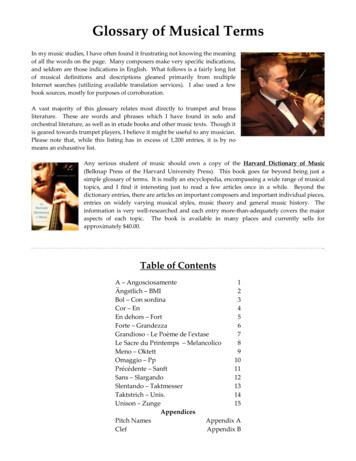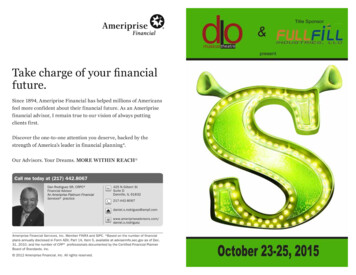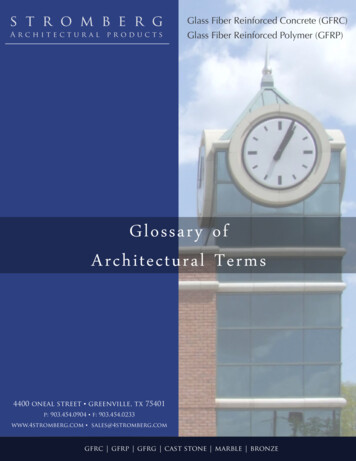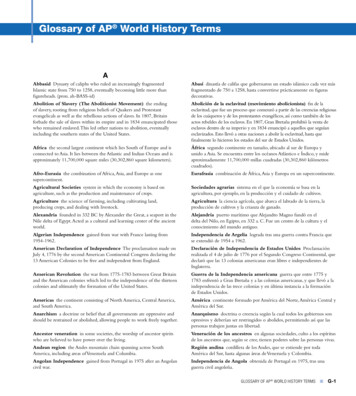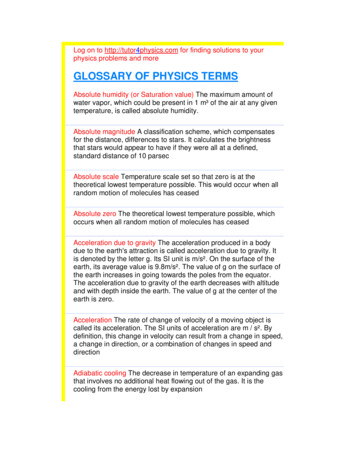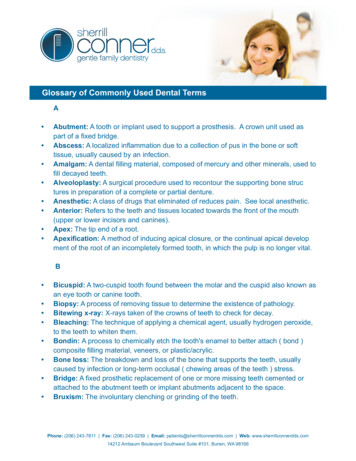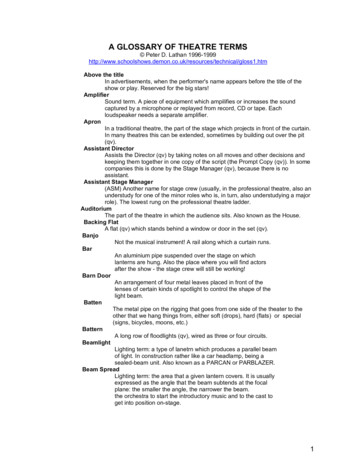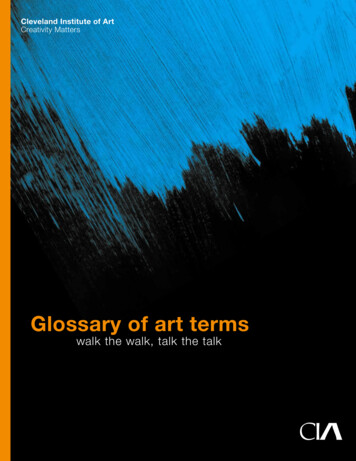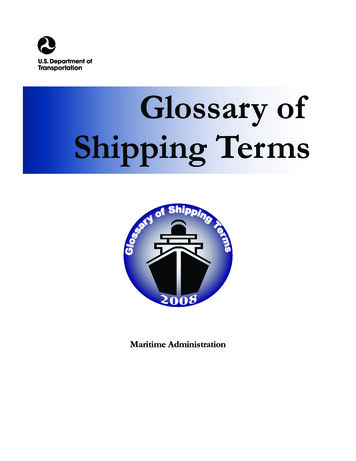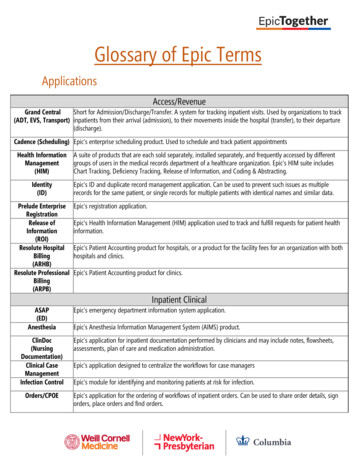
Transcription
GLOSSARY OF MUSICAL TERMSAabsolute music: instrumental music with no intended story (non-programmatic music)a cappella: choral music with no instrumental accompanimentaccelerando: gradually speeding up the speed of the rhythmic beataccent: momentarily emphasizing a note with a dynamic attackadagio: a slow tempoallegro: a fast tempoalto: a low-ranged female voice; the second lowest instrumental rangeandante: moderate tempo (a walking speed; "Andare" means to walk)aria: a beautiful manner of solo singing, accompanied by orchestra, with a steady metrical beatart-music: a general term used to describe the "formal concert music" traditions of the West, as opposedto "popular" and "commercial music" styles.art song: (genre) a musical setting of artistic poetry for solo voice accompanied by piano (or orchestra)atonality: modern harmony that intentionally avoids a tonal center (has no apparent home key)augmentation: lengthening the rhythmic values of a fugal subjectavant-garde: ("at the forefront") a French term that describes highly experimental modern musical stylesBballet: (genre) a programmatic theatrical work for dancers and orchestrabar: a common term for a musical measurebaritone: a moderately low male voice; in range between a tenor and a bassBaroque Era: c1600-1750; a musical period of extremely ornate and elaborate approaches to the arts.This era saw the rise of instrumental music, the invention of the modern violin family and the creationof the first orchestras (Vivaldi, Handel, JS Bach)bass: the lowest male voice; (see Double Bass)bass drum: the lowest-sounding non-pitched percussion instrumentbasso continuo: the back-up ensemble of the Baroque Era usually comprised of a keyboard instrument(harpsichord or organ) and a melodic stringed bass instrument ( viol' da gamba or cello)bassoon: the lowest-sounding regular instrument of the woodwind family (a double-reed instrument)beat: a musical pulsebebop: a complex, highly-improvisatory style of jazz promoted by Charlie Parker in the 1940s-50s"Big Band" jazz: see "Swing"binary form: a form comprised of two distinctly opposing sections ("A" vs. "B")bitonality: modern music sounding in two different keys simultaneouslyBlues: a melancholy style of Afro-American secular music, based on a simple musical/poetic form. "Dlta"blues began in the early 1900s; "Classic" blues in the late 1920s; "Rhythm and Blues" in the 1940s.brass instrument: a powerful metallic instrument with a mouthpiece and tubing that must be blown intoby the player, such as trumpet, trombone, French horn, tuba, baritone, bugel131
Glossary of Musical TermsCcadence: a melodic or harmonic punctuation mark at the end of a phrase, major section or entire workcadenza: an unaccompanied section of virtuosic display played by a soloist in a concertocall and response: a traditional African process in which a leader's phrase ("call") is repeatedlyanswered by a chorus. This process became an important aspect of many Afro-American styles.canon: a type of strict imitation created by strict echoing between a melodic "leader" and subsequent"follower(s)"cantata: (genre) a composition in several movements, written for chorus, soloist(s) and orchestra;traditionally, these are religious works.cello: the tenor-ranged instrument of the modern string family (an abbreviation for violoncello)chamber music: (genre) music performed by a small group of players (one player per part)chance music: (genre) a modern manner of composition in which some or all of the work is left to chancechant: (genre) a monophonic melody sung in a free rhythm (such as "Gregorian" chant of the RomanCatholic Church)character piece: (genre) a 1-movement programmatic work for a solo pianistchimes: a percussion instrument comprised of several tube-shaped bells struck by a leather hammerchorale: 1) a Lutheran liturgical melody; 2) a 4-part hymn-like chorale harmonizationchord: a harmonic combination that has three or more pitches sounding simultaneouslychorus: 1) a fairly large choral group; 2) in Jazz, a single statement of the main harmonic/melody patternchromaticism: 1) harmonic or melodic movement by half-step intervals; 2) harmony that uses pitchesbeyond the central key of a workclarinet: the tenor-ranged instrument of the woodwind family (a single-reedClassic Era: c1750-1820; a politically turbulent era focused on structural unity, clarity and balance.(Haydn, Mozart, Beethoven)coda: (means "tail" in Italian) a concluding section appended to the end of a workcollegium musicum: a university ensemble dedicated to the performance of early music (pre- 1750)computer music: music in which the composition and/or performance is controlled by a computerconcert band: a large (non-marching) ensemble of woodwind, brass and percussion instrumentsconcerto: (genre) the general term for a multi-movement work for soloist(s) and orchestra (see "soloconcerto" and "concerto grosso")concerto grosso: (genre) a 3-movement work for a small group of soloists and orchestraconductor: the leader of a performing group of musiciansconsonance: pleasant-sounding harmonycontrabassoon: the lowest-sounding double-reed instrument of the woodwind family"cool" jazz: a relaxed style of modern jazz, promoted in the 1950s/60s by Brubeck etc.cornet: a mellow-sounding member of the trumpet familycountermelody: a secondary melodic idea that accompanies and opposes a main thematic ideacounterpoint: a complex polyphonic texture combining two or more independent melodiescrescendo: gradually getting loudercymbals: percussion instrument usually consisting of two circular brass plates struck together as a pair132
Glossary of Musical TermsDda capo: (Italian "to the head") a written indication telling a performer to go back to the start of a piecedecrescendo: gradually getting quieter (see diminuendo)development: 1) the central dramatic section of a sonata form that moves harmonically through manykeys; 2) the process of expanding or manipulation a musical ideadiatonic: a melody or harmony based on one of the seven-tone major or minor Western scalesDies Irae: a chant from the Requiem Mass dealing with God's wrath on the day of judgmentdiminuendo: gradually getting quieter (see decrescendo)diminution: the shorten the note values of a theme (usually to render it twice as fast)decrescendo: gradually getting quieter (see diminuendo)disjunct: a melody that is not smooth in contour (has many leaps)Doctrine of Affections: the Baroque methodology for evoking a specific emotion through music and textdotted note: a written note with a dot to the right of it (the dot adds half the rhythmic duration to the note'soriginal value)double bass: the lowest-sounding instrument of the modern string familydownbeat: the first beat of a musical measure (usually accented more strongly than other beats)duple meter: a basic metrical pattern having two beats per measuredynamics: the musical element of relative musical loudness or quietnessEelectric instrument: an instrument whose sound is produced or modified by an electro-magnetic pick-upelectronic instrument: an instrument whose sound is produced or modified by electronic meansenglish horn: a tenor oboe; a richly nasal-sounding double-reed woodwind instrumentensemble: a group of musical performersepisode: an intermediary (contrasting) section of a Baroque fugue or Classic rondo formequal temperament: the standard modern tuning system in which the octave is divided into twelve equal"half-steps"étude: (French) a "study" piece, designed to help a performer master a particular techniqueexposition: 1) the opening section of a fugue; 2) the opening section of a Classic sonata form (in whichthe two opposing key centers are exposed to the listener for the first time)expressionism: an ultra-shocking, highly-dissonant modern style of musicFfalsetto: a vocal technique that allows a male to sing in a much higher, lighter register (by vibrating onlyhalf of the vocal cord)flat sign: (b) a musical symbol that lowers the pitch one half-stepflute: a metal tubular instrument that is the soprano instrument of the standard woodwind familyform: the elemental category describing the shape/design of a musical work or movementfilm music: (genre) music that serves either as background or foreground material for a movieforte: (f) a loud dynamic marking133
Glossary of Musical Termsfortepiano: an early prototype of the modern piano (designed to play both "loud" and "quiet")fortissimo: (ƒ) a very loud dynamic markingfrench horn: a valved brass instrument of medium/medium-low range (alto to bass)fugue: a complex contrapuntal manipulation of a musical subjectfusion: a blending of jazz and rock stylesGgamelan: an Indonesian musical ensemble comprised primarily of percussion instrumentsgenre: a category of musical composition (the specific classification of a musical work)glissando: a rapid slide between two distant pitchesglockenspiel: a pitched-percussion instrument comprised of metal bars in a frame struck by a malletgong: (also called "tam-tam") a non-pitched percussion instrument made of a large metal plate struckwith a malletgrave: a slow, solemn tempoGregorian chant: (genre) monophonic, non-metered melodies set to Latin sacred textsguitar: a six-stringed fretted instrumentHhabañera: an exotic Cuban dance in duple meterhalf step: the smallest interval in the Western system of equal temperamentharmony: the elemental category describing vertical combinations of pitchesharp: a plucked instrument having strings stretched on a triangular frameharpsichord: an ancient keyboard instrument whose sound is produced by a system of levered picks thatpluck its metal strings (common in the Renaissance and Baroque eras)home key: see tonic keyhomophonic texture: 1) a main melody supported by chord; 2) a texture in which voices on differentpitches sing the same words simultaneouslyhorn: see French horn"hot" jazz: a "Dixieland" style of jazz with a fast tempo promoted by Louis ArmstrongIidée fixe: a transformable melody that recurs in every movement of a multi-movement workimitation: a polyphonic texture in which material is presented then echoed from voice to voiceImpressionism: a modern French musical style based on blurred effects, beautiful tone colors and fluidrhythms (promoted by Debussy around the turn of the 1900s)improvisation: "on-the-spot" creation of music (while it is being performed)incidental music: (genre) music performed during a theatrical playinstrumentation: the combination of instruments that a composition is written forinterval: the measured distance between two musical pitchesinversion: a variation technique in which the intervals of a melody are turned upside down134
Glossary of Musical TermsJjazz: (genre) a style of American modern popular music combining African and Western musical traitsjazz band: an instrumental ensemble comprised of woodwinds (saxophones and clarinets), brasses(trumpets and trombones) and rhythm section (piano/guitar, bass and drum set)Kkettledrums: see timpanikey: the central note, chord or scale of a musical composition or movementkey signature: a series of sharps or flats written on a musical staff to indicate the key of a compositionkeyboard instrument: any instrument whose sound is initiated by pressing a series of keys with thefingers; piano, harpsichord, organ, synthesizer are the most common typeskoto: a Japanese plucked instrument with 13 strings and moveable bridgesLlargo: a very slow, broad tempolegato: a smooth, connected manner of performing a melodyLeitmotif: a short musical "signature tune" associated with a person or concept in a WagnerianMusikdramalibretto: the sung/spoken text of an operaLied: (genre) a German-texted art song (usually for one voice with piano accompaniment); plural Liederlute: an ancient pear-shaped plucked instrument widely used in the Renaissance and Baroque erasMmadrigal: (genre) a composition on a short secular poem, sung by a small group of unaccompaniedsingers (one on a part). The madrigal flourished in Italy from 1520 to 1610, and was adopted inEngland during the Elizabethan Age (c. 1600)major key: music based on a major scale (traditionally considered "happy" sounding)major scale: a family of seven alphabetically-ordered pitches within the distance of an octave, followingan intervalic pattern matching the white keys from "C" to "C" on a piano).marching band: an large ensemble of woodwinds, brass, and percussion used for entertainment atsporting events and parades (usually performing march-like music in a strong duple meter).marimba: a pitched percussion instrument comprised of wooden bars struck by malletsMass: (genre) in music, a composition based on the five daily prayers of the Roman Catholic MassOrdinary: Kyrie, Gloris, Credo, Sanctus, Agnus Dei.Mass Ordinary: the five daily prayers of the Catholic Mass: Kyrie, Gloris, Credo, Sanctus, Agnus DeiMass Proper: the approximately two dozen prayers of a Mass that change each day to reflect theparticular feast day of the liturgical calendarmarimba: a pitched percussion instrument comprised of wooden bars struck by mallets; a mellowerversion of the xylophonemazurka: a type of Polish dance in triple meter, sometimes used by Chopin in his piano works135
Glossary of Musical Termsmeasure: a rhythmic grouping, set off in written music by a vertical barlineMedieval: a term used to describe things related to the Middle Ages (c450-1450)melisma: a succession of many pitches sung while sustaining one syllable of textmelody: the musical element that deals with the horizontal presentation of pitchmeter: beats organized into recurring and recognizable accent patterns (2/4, 3/4, 4/4, etc.)metronome: a mechanical (or electric) device that precisely measures tempomeasure: a rhythmic grouping, set off in written music by a vertical barlinemezzo-: an Italian prefix that means "medium"mezzo-forte: (F) a medium loud dynamic markingmezzo-piano: (f) a medium quiet dynamic markingmezzo-soprano: a dramatic wo
art-music: a general term used to describe the "formal concert music" traditions of the West, as opposed to "popular" and "commercial music" styles. art song: (genre) a musical setting of artistic poetry for solo voice accompanied by piano (or orchestra) atonality: modern harmony that intentionally avoids a tonal center (has no apparent home key)
